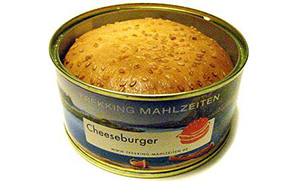14 Must-Have Canned Foods You Didn’t Know About
There’s a reason preppers and even just people who like a well-stocked pantry purchase canned goods. They hold up for a long time, years even. They’re generally easy to prepare, many items requiring no more preparation than a quick warming in order to make sure the food is free from harmful microorganisms. Cans also come ready to store, no extra prep needed to sock them away for long-term storage.
Plenty of staples like beans, soup, veggies, fruit, and pasta are commonly found in the average family’s pantry, and found in great quantities in preppers’ stores. Those staples would get boring quickly, though. If you’re looking to add some unique and exotic foods to your food storage for either variety in your diet or for trading, read on for a look at the following canned goods you didn’t know existed.
1. Bread
Canned bread is totally a thing, and it’s available in several different varieties. While it’s likely more practical to store ingredients to make your own bread for the long-term, canned bread could be a tasty, quick way to a full belly and to get some carbohydrates into your system. You can find Original and Raisin Brown Bread by B & M in many stores or online.
2. Butter
Would you miss butter if you suddenly didn’t have access to the supermarket? No big deal, you can get that canned, too. There are a few brands of canned butter available, and it’s rather expensive since it’s not canned in the US. However, it’d be a lovely treat in a SHTF situation, and fat is a crucial part of the diet. For a less expensive canned butter, opt for powdered butter, instead.

3. Pudding
Canned pudding is more often found in Europe, but you can find it in stores in the US, too, as any buffet or cafeteria worker attest. Whatever your favorite type of pudding, it’s likely available in a can.

4. Cake
A pudding in the European sense that refers more to a desert dish in general, you can get canned Spotted Dick made by Simpson’s. It’s essentially a sponge cake with spices and raisins. While it doesn’t quite fit into what we think of as a cake in everyday life, I bet it’d be an incredible birthday treat in a SHTF situation.

5. Bacon
Very few people don’t like bacon, so it’s great that Yoder makes it in a can for long-term storage. It’s salty, fatty, and flavorful, which makes it great for spicing up boring food made from more traditional prepper food items. You don’t need much of it to transform a pot of soup or some powdered eggs.

6. Cheese
While making your own cheese isn’t rocket science, there is a lot of actual science involved, and the raw materials needed may not be easy to come by. So, there’s canned cheese. While it’s not quite like what we think of as ‘real’ cheese, canned cheese has plenty of fat and flavor to be a worthwhile addition to your prepper’s pantry. Check out Kraft’s Prepared Pasteurized Cheddar cheese or Heinz’s Macaroni Cheese for reasonably priced options.

7. Hamburger
Generally, people think of canned hamburger being home-canned. However, it’s available in cans from both Yoders and Keystone. There are even pre-seasoned canned hamburger products available, like the taco meat by Yoders.

8. Whole Chicken
Canned whole chicken, like those available from Sweet Sue, are good for more than just the meat. When the entire chicken is canned, all the gelatin and fat is preserved, allowing you to make a fantastic chicken soup.

9. Sandwiches
Also known as the Candwich, these canned sandwiches will be available in several different flavors. They haven’t quite hit the open market yet, but they’re coming! They come in a can about the size of a soda can with a peel off top. They’re perfect for on-the-go eating.

10. Potato Salad
Who knew this traditional, delicious picnic side was available in a can? Canned potato salad would be a good way to add a little flavor into your preps, and it can be eaten warm or chilled, making it a more versatile side dish than you’d possibly realized.

11. Tamales
We’re talking whole tamales here. Simply heat these canned tamales up, maybe add some fresh veggies or canned cheese to them, and voila! You’ve created an entire meal by simply opening the can. These provide a ready-made meal in a solid form, which can have profound positive psychological impacts. While canned soup is great for filling you up and providing a decent balance, it’s simply not the most satisfying food out there.

12. Cheeseburger
Made in Switzerland, these rather expensive canned cheeseburgers aren’t very practical, but they’re a fun addition to your preps. You simply boil the whole can and open for a tasty (that’s subjective, of course) cheeseburger.

13. Escargot
Even if you don’t care much for fancy seafood, there are plenty of canned sea food items that could be great for bartering. Apart from escargot, you can find crab, lobster, and other shellfish canned for long-term storage.

14. Duck Confit
Popular in France, canned duck with fat doesn’t seem terribly popular in the US. However, the high fat content in this canned dish could prove to be helpful in a SHTF situation. It’s great for soups and stews, and it adds a sumptuous touch that you won’t often find in the world of canned goods.
Conclusion
Whatever you prepping goals, consider adding some non-conventional canned goods to your stores. Variety, after all, is the spice of life. We need a variety of foods to stay at our healthiest, and because of this, people generally want a bit of variety in their diet.
The humor factor that many of the above items bring to the table shouldn’t be discounted, either. Psychological health will be remarkable important if society collapses, as well, so attending to our psychological needs shouldn’t be overlooked. As is always the case with canned good storage, be sure you’re properly storing cans and rotating your stock as necessary.
Whatever you prepping goals, consider adding some non-conventional canned goods to your stores. Variety, after all, is the spice of life.




